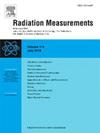基于DoseCalcs平台的新型网格型成年男性和女性计算模型更新I-131内部剂量学系数
IF 2.2
3区 物理与天体物理
Q2 NUCLEAR SCIENCE & TECHNOLOGY
引用次数: 0
摘要
放射性核素在核医学中用于诊断和治疗目的,是现代癌症治疗的基石,特别是在使用碘-131时。当碘-131被施用时,它被设计成专门针对甲状腺,向肿瘤提供最大的辐射能量。然而,碘-131通过血液循环,到达身体的各个部位,使它们暴露在辐射之下。在这种情况下,精确的剂量学计算对于确保治疗的安全性和有效性至关重要。我们使用最新的网格型幻影世代来更新来自风格化和基于体素的幻影的现有s值,利用最新幻影模型中增强的器官/组织解剖表示。为了进行模拟,我们使用了基于蒙特卡罗的DoseCalcs平台,在该平台上,我们使用了ICRP Publication 145提供的解剖特征(如形状数据和区域化学成分)和ICRP Publication 107提供的I-131辐射数据来模拟I-131发射的辐射传输,并计算了几种源器官组合的相应s值。我们利用成年男女的网格型模型计算了9个源区和28个目标区的I-131 s值。当将这些值与使用基于体素的幻影计算的值进行比较时,我们观察到对于大多数目标←源组合,这两个数据集通常是相似的。然而,我们发现了显著的差异,特别是在远端组合(例如,大脑←膀胱内容物)和邻近区域,如内容物和膀胱壁组合。在某些情况下,比例达到4(如胃壁←胃内容物,膀胱壁←膀胱内容物)。这些结果强调了几何修改对网格型幻影的影响,特别是对于墙壁区域,其中解剖表示与基于体素的幻影有很大不同。本文章由计算机程序翻译,如有差异,请以英文原文为准。
Updating internal dosimetry coefficients of I-131 based on new mesh-type computational phantoms of adult male and female using the DoseCalcs platform
The use of radionuclides in nuclear medicine, both for diagnostic and therapeutic purposes, represents a cornerstone of modern cancer treatment, particularly when utilizing iodine-131. When iodine-131 is administered, it is designed to specifically target the thyroid gland, delivering maximum radiation energy to the tumor. However, iodine-131 circulates through the bloodstream and reaches various regions in the body, exposing them to radiation. In this context, accurate dosimetry calculations are essential to ensure both the safety and efficacy of the treatment.
We used the latest mesh-type phantom generations to update existing S-values derived from stylized and voxel-based phantoms, leveraging the enhanced anatomical representation of organs/tissues in the latest phantom models.
To perform the simulations, we used the Monte Carlo-based DoseCalcs platform, in which we implemented anatomical characteristics such as shape data and chemical composition of regions provided by ICRP Publication 145 and radiation data of I-131 from ICRP Publication 107 to simulate the transport of radiation emitted by I-131 and calculate the corresponding S-values for several source-organ combinations.
We calculated I-131 S-values for nine source regions and twenty-eight target regions using mesh-type phantoms of adult male and female. When comparing these values with those calculated using voxel-based phantoms, we observed that the two datasets were generally similar for most targetsource combinations. However, notable differences were identified, particularly for distant combinations (e.g., brain urinary bladder contents) and adjacent regions such as content and wall combinations. In some cases, the ratio reached up to 4 (e.g., stomach wall stomach contents, urinary bladder wall urinary bladder contents).
These results underscore the impact of geometric modifications in mesh-type phantoms, particularly for wall regions, where anatomical representations differ significantly from voxel-based phantoms.
求助全文
通过发布文献求助,成功后即可免费获取论文全文。
去求助
来源期刊

Radiation Measurements
工程技术-核科学技术
CiteScore
4.10
自引率
20.00%
发文量
116
审稿时长
48 days
期刊介绍:
The journal seeks to publish papers that present advances in the following areas: spontaneous and stimulated luminescence (including scintillating materials, thermoluminescence, and optically stimulated luminescence); electron spin resonance of natural and synthetic materials; the physics, design and performance of radiation measurements (including computational modelling such as electronic transport simulations); the novel basic aspects of radiation measurement in medical physics. Studies of energy-transfer phenomena, track physics and microdosimetry are also of interest to the journal.
Applications relevant to the journal, particularly where they present novel detection techniques, novel analytical approaches or novel materials, include: personal dosimetry (including dosimetric quantities, active/electronic and passive monitoring techniques for photon, neutron and charged-particle exposures); environmental dosimetry (including methodological advances and predictive models related to radon, but generally excluding local survey results of radon where the main aim is to establish the radiation risk to populations); cosmic and high-energy radiation measurements (including dosimetry, space radiation effects, and single event upsets); dosimetry-based archaeological and Quaternary dating; dosimetry-based approaches to thermochronometry; accident and retrospective dosimetry (including activation detectors), and dosimetry and measurements related to medical applications.
 求助内容:
求助内容: 应助结果提醒方式:
应助结果提醒方式:


